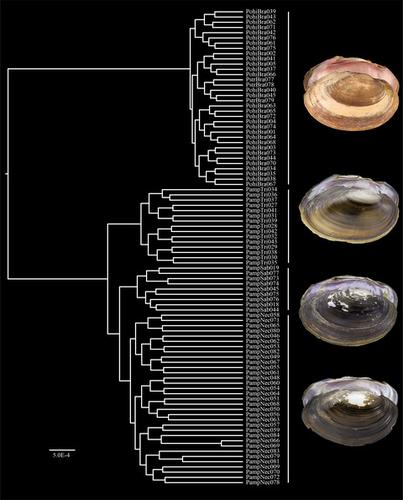当前位置:
X-MOL 学术
›
Ecol. Evol.
›
论文详情
Our official English website, www.x-mol.net, welcomes your
feedback! (Note: you will need to create a separate account there.)
Establishing conservation units to promote recovery of two threatened freshwater mussel species (Bivalvia: Unionida: Potamilus)
Ecology and Evolution ( IF 2.3 ) Pub Date : 2021-07-31 , DOI: 10.1002/ece3.7897 Chase H Smith 1, 2, 3 , Nathan A Johnson 4 , Clinton R Robertson 5 , Robert D Doyle 3 , Charles R Randklev 2
Ecology and Evolution ( IF 2.3 ) Pub Date : 2021-07-31 , DOI: 10.1002/ece3.7897 Chase H Smith 1, 2, 3 , Nathan A Johnson 4 , Clinton R Robertson 5 , Robert D Doyle 3 , Charles R Randklev 2
Affiliation

|
Population genomics has significantly increased our ability to make inferences about microevolutionary processes and demographic histories, which have the potential to improve protection and recovery of imperiled species. Freshwater mussels (Bivalvia: Unionida) represent one of the most imperiled groups of organisms globally. Despite systemic decline of mussel abundance and diversity, studies evaluating spatiotemporal changes in distribution, demographic histories, and ecological factors that threaten long-term persistence of imperiled species remain lacking. In this study, we use genotype-by-sequencing (GBS) and mitochondrial sequence data (mtDNA) to define conservation units (CUs) for two highly imperiled freshwater mussel species, Potamilus amphichaenus and Potamilus streckersoni. We then synthesize our molecular findings with details from field collections spanning from 1901 to 2019 to further elucidate distributional trends, contemporary status, and other factors that may be contributing to population declines for our focal species. We collected GBS and mtDNA data for individuals of P. amphichaenus and P. streckersoni from freshwater mussel collections in the Brazos, Neches, Sabine, and Trinity drainages ranging from 2012 to 2019. Molecular analyses resolved disputing number of genetic clusters within P. amphichaenus and P. streckersoni; however, we find defensible support for four CUs, each corresponding to an independent river basin. Evaluations of historical and recent occurrence data illuminated a generally increasing trend of occurrence in each of the four CUs, which were correlated with recent increases in sampling effort. Taken together, these findings suggest that P. amphichaenus and P. streckersoni are likely rare throughout their respective ranges. Because of this, the establishment of CUs will facilitate evidence-based recovery planning and ensure potential captive propagation and translocation efforts are beneficial. Our synthesis represents a case study for conservation genomic assessments in freshwater mussels and provides a model for future studies aimed at recovery planning for these highly imperiled organisms.
中文翻译:

建立保护单位以促进两种受威胁淡水贻贝物种(双壳纲:Unionida:Potamilus)的恢复
群体基因组学显着提高了我们对微进化过程和人口历史进行推断的能力,这有可能改善濒危物种的保护和恢复。淡水贻贝(双壳纲:Unionida)是全球最濒危的生物群体之一。尽管贻贝丰度和多样性出现系统性下降,但评估分布时空变化、种群历史和威胁濒危物种长期存在的生态因素的研究仍然缺乏。在这项研究中,我们使用基因型测序 (GBS) 和线粒体序列数据 (mtDNA) 来定义两种高度濒危的淡水贻贝物种Potamilus amphichaenus和Potamilus streckersoni 的保护单位 (CU)。然后,我们将分子研究结果与 1901 年至 2019 年实地收集的详细信息进行综合,以进一步阐明分布趋势、当代状况以及可能导致我们重点物种种群数量下降的其他因素。我们从 2012 年至 2019 年期间,从 Brazos、Neches、Sabine 和 Trinity 流域的淡水贻贝收藏中收集了P. amphichaenus和P. streckersoni个体的 GBS 和 mtDNA 数据。分子分析解决了P. amphichaenus和 P. streckersoni 内遗传簇数量的争议。 P. streckersoni ;然而,我们发现对四个 CU 的支持是合理的,每个 CU 对应一个独立的流域。对历史和近期发生数据的评估揭示了四个 CU 中每一个的发生总体呈增加趋势,这与近期抽样工作的增加相关。 总而言之,这些发现表明P. amphichaenus和P. streckersoni在其各自的分布范围内可能很罕见。因此,CU 的建立将促进基于证据的恢复计划,并确保潜在的圈养繁殖和易位工作是有益的。我们的合成代表了淡水贻贝保护基因组评估的案例研究,并为旨在这些高度危险的生物体的恢复规划的未来研究提供了模型。
更新日期:2021-08-16
中文翻译:

建立保护单位以促进两种受威胁淡水贻贝物种(双壳纲:Unionida:Potamilus)的恢复
群体基因组学显着提高了我们对微进化过程和人口历史进行推断的能力,这有可能改善濒危物种的保护和恢复。淡水贻贝(双壳纲:Unionida)是全球最濒危的生物群体之一。尽管贻贝丰度和多样性出现系统性下降,但评估分布时空变化、种群历史和威胁濒危物种长期存在的生态因素的研究仍然缺乏。在这项研究中,我们使用基因型测序 (GBS) 和线粒体序列数据 (mtDNA) 来定义两种高度濒危的淡水贻贝物种Potamilus amphichaenus和Potamilus streckersoni 的保护单位 (CU)。然后,我们将分子研究结果与 1901 年至 2019 年实地收集的详细信息进行综合,以进一步阐明分布趋势、当代状况以及可能导致我们重点物种种群数量下降的其他因素。我们从 2012 年至 2019 年期间,从 Brazos、Neches、Sabine 和 Trinity 流域的淡水贻贝收藏中收集了P. amphichaenus和P. streckersoni个体的 GBS 和 mtDNA 数据。分子分析解决了P. amphichaenus和 P. streckersoni 内遗传簇数量的争议。 P. streckersoni ;然而,我们发现对四个 CU 的支持是合理的,每个 CU 对应一个独立的流域。对历史和近期发生数据的评估揭示了四个 CU 中每一个的发生总体呈增加趋势,这与近期抽样工作的增加相关。 总而言之,这些发现表明P. amphichaenus和P. streckersoni在其各自的分布范围内可能很罕见。因此,CU 的建立将促进基于证据的恢复计划,并确保潜在的圈养繁殖和易位工作是有益的。我们的合成代表了淡水贻贝保护基因组评估的案例研究,并为旨在这些高度危险的生物体的恢复规划的未来研究提供了模型。











































 京公网安备 11010802027423号
京公网安备 11010802027423号